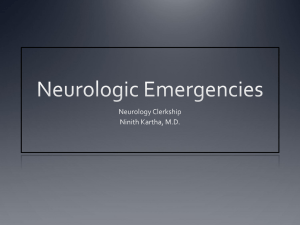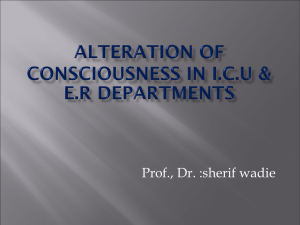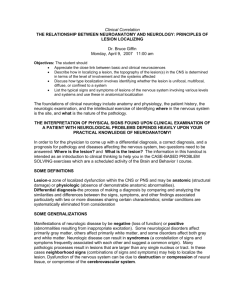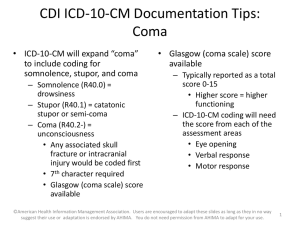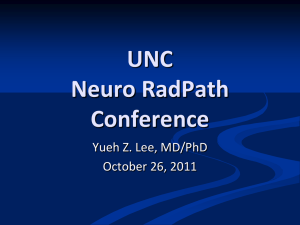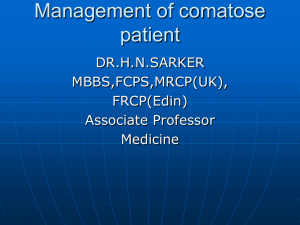Neurologic Emergencies
advertisement
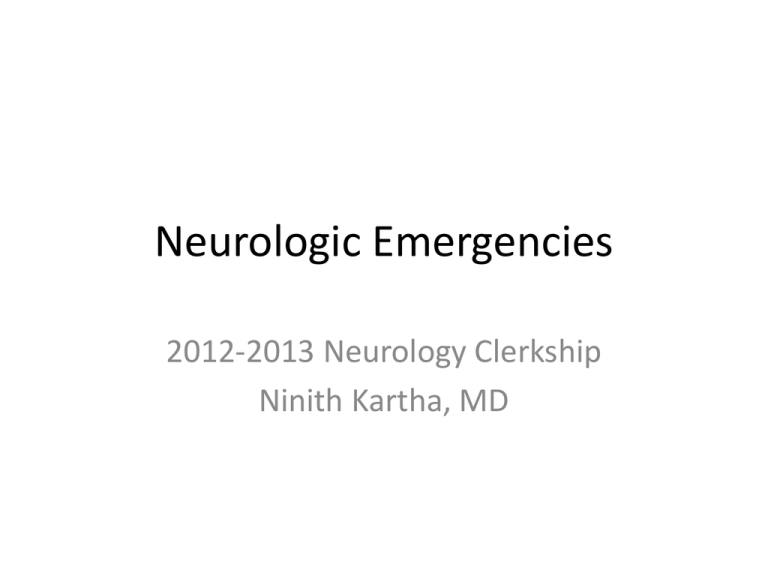
Neurologic Emergencies 2012-2013 Neurology Clerkship Ninith Kartha, MD Case 1 • A 71 year old man presents for progressive difficulty walking – Developed back pain several weeks ago – Followed by numbness and weakness in the legs • Physical Examination – – – – – – – Vitals stable Cranial nerves normal Hypertonia in LE with moderate weakness; UE normal Hyperreflexia in LE; UE normal Extensor plantar responses bilaterally Sensation reduced to all modalities to mid-abdomen Spastic gait Case 1 • Can you localize the lesion? Localization Central nervous system • Brain • Spinal cord Peripheral nervous system • • • • • Nerve root Plexus Peripheral nerve Neuromuscular junction Muscle The most important step in neurologic localization is differentiating a central nervous system lesion from a peripheral nervous system lesion 4 Localization Upper motor neuron • • • • Mildly reduced bulk Increased tone (spasticity) Mild/moderate weakness Hyperreflexia; pathologic reflexes (Babinski, Hoffman) Grading muscle power 5: Full strength 4: Movement against some resistance 3: Movement against gravity only 2: Movement with gravity eliminated 1: Flicker or trace contraction 0: No contraction 5 Lower motor neuron • Severely reduced bulk with fasciculations • Reduced tone (flaccidity) • Severe weakness • Hyporeflexia Grading reflexes 4: Hyper with pathologic responses 3: Hyperactive 2: Normal 1: Diminished 0: Absent Localization • Spinal levels C5/6 Its easy to remember…1/2, 3/4, 5/6, 7/8 C7/8 ALWAYS ABNORMAL: L3/4 Asymmetric reflexes Pathologic responses (Babinski, clonus = CNS) Absent reflexes (PNS) S1/2 6 Case 1 • What studies do you want to order and why? Where does the spinal cord end? Spinal Cord Compression Management • Dexamethasone (100 mg IV followed by 16 mg PO daily in divided doses) • Surgical evaluation • Radiotherapy Differential Metastatic disease Epidural hematoma Epidural abscess Vertebral collapse (2’ malignancy) Aortic dissection Case 2 • A 28 year old man presents for progressive difficulty walking – “Stomach flu” 2 weeks ago – Recently developed low back pain and numbness in his feet – Difficulty standing and climbing stairs, tripping frequently • Physical Examination – Vitals stable – Cranial nerves normal – Mild hypotonia, normal muscle bulk; mild distal LE weakness Case 2 • Can you localize the lesion? Localization Central nervous system • Brain • Spinal cord Peripheral nervous system • • • • • Nerve root Plexus Peripheral nerve Neuromuscular junction Muscle The most important step in neurologic localization is differentiating a central nervous system lesion from a peripheral nervous system lesion 13 Localization Neuropathy Myopathy Myelopathy NMJ disorder Weakness Distal > proximal Proximal > distal Below level of lesion Fluctuating/ muscle fatigue Deep tendon reflexes Severe reduction/ early loss Mild reduction/ late loss Increased Normal or mildly reduced Sensory Distal/ ascending Preserved Sensory level Preserved Case 2 • What studies do you want to order and why? Guillain-Barre Syndrome • CSF: cytoalbuminological dissocation (elevated protein with few or no mononuclear cells) • May be normal in the first week • If WBC count >10 consider Lyme, HIV, sarcoidosis • Electromyography/nerve conduction study • Reduced nerve conduction velocities • Conduction block • Prolonged F-waves • Antiganglioside antibodies • GM1 Abs (correlate with C. jejuni infection) • GQ1b associated with C. Miller Fisher variant (ataxia, 16 Guillain-Barre Syndrome • Typically follows an infectious process (2/3) – C. jejuni, CMV, EBV, M. pneumoniae • Presents with ascending numbness/tingling, can be painful • Weakness typically follows sensory disturbances • Areflexia • Autonomic dysfunction – Labile BP, arrhythmia – Bowel and bladder function typically spared • Symptoms should not proceed >8 weeks – 98% achieve “plateau phase” by 4 weeks – Duration of “plateau” 12 days 17 Treatment • Telemetry, respiratory parameters, ICU monitoring for dysautonomia and respiratory compromise • IVIG (0.4g/kg/day for 5 days) versus plasma exchange – Ease of administration, fewer complications, preferred in hemodynamically unstable patients – Should be started within 2 weeks • Corticosteroids have not been shown to be beneficial • Intubation criteria: – VC <15-20 mL/kg (<30% baseline) – PO2<70 mmHg – Oropharyngeal weakness, weak cough, suspected aspiration 18 GBS vs ATM Case 3 • A 34 year old woman presents to the ER with complaint of eyelid drooping – A week earlier went to ER and given steroids for an asthma exacerbation and ciprofloxacin for an asymptomatic UTI – Feels “weak all over,” progressively short of breath • Physical Examination – Speech is soft with a nasal quality – Fluctuating bilateral ptosis, pupils equal and reactive, “snarl” smile – Normal bulk/tone; strength can be overcome after Case 3 • Can you localize the lesion? • What studies do you want to order and why? Acute treatment • Respiratory parameters – 30% of pts develop respiratory muscle weakness and crisis occurs in 15-20% • Telemetry: 14% of pts in myasthenic crisis have some degree of arrhythmias • Intubation criteria – VC < 15 mL/kg – Stop anti-cholinesterase medication (causes excessive bronchial secretions and diarrhea) • PE (improvement in 75%), IV Ig Myasthenia gravis • Ice pack test: improves ptosis in MG > 80% • Tensilon test (edrophonium) • Repetitive stimulation or single fiber EMG • Autoimmune work up • AchR Ab – 85% w/ gMG – 50-60% w/ oMG • Chest CT • Thymectomy may increase chances of remission • May be less effective in ocular myasthenia and those >60 Case 4 • A 27 year old woman is brought to the ER for “sudden onset of confusion” • Physical Examination – Global aphasia: unable to produce spontaneous language, repeat phrases or follow commands – Right lower facial weakness – Right arm weakness Case 4 • Can you localize the lesion? Localization • Central nervous system • Left hemisphere – Dominant in 99% of R handers, 60-70% L handers • Cortex: perisylvian language area – Expressive, nonfluent aphasia (frontal lobe) – Receptive aphasia (temporal lobe) Acute stroke symptoms • Hemiparesis or isolated limb weakness • Hemisensory deficit • Monocular or binocular (typically homonymous) vision loss • Brainstem deficits (diplopia, dysphagia, deafness, crossed sensory or motor signs) • Ataxia of limbs or gait • Cortical signs (aphasia, neglect, apraxia…) Subcortical strokes • Caused by occlusion of small penetrating branches of cerebral arteries • Chronic HTN>DM>emboli Syndrome Presentation Localization Pure Motor Face, arm, leg Internal capsule Pure Sensory Face, arm, leg Thalamus Sensorimotor Face, arm, leg Thalamocapsular Ataxichemiparesis Hemi-ataxia & hemiparesis Basis pontis Clumsy hand dysarthria Dysathria, incoordination Genu of the IC 28 Acute stroke syndrome • A-B-C’s – NPO, intubate for inadequate airway, ventilate if needed – Correct hypotension, rule out acute MI or arrhythmia (a-fib) • Rule out hypoglycemia – Blood glucose is between 50 and 400 mg/dl – Minimize hyperglycemia by running an IV of 0.9% normal saline initially at a TKO rate • Use parenteral antihypertensive Tx only for sustained, very high BP (>220/120; or >185/110 for IV tPA) • IV tPA must be/may be given within 4.5 hrs of stroke onset • Neuro deficit (NIHSS score 5 to 22) must not be rapidly improving (TIA) or post-ictal • Normal PTT, PT<15 sec, platelets >100,000 • No bleeding, recent surgery, MI, arterial puncture or LP • No blood, or edema/infarct > 1/3 of MCA territory on CT – BP maintained under 185/110 TIME IS BRAIN!!! Diagnostic tests • What imaging test do you want to order? • CT scan – in deteriorating patient, quickly rules out hemorrhage, mass (tumor, abscess) or early infarct edema – shows cortical infarcts by 1-2 days, may miss lacunar infarcts • MRI scan – highest resolution scan, but longer scanning time – DWI (diffusion weighted imaging) detects impaired movement of water in infarct immediately – non-invasively view arterial supply (MRA) – contraindications: pacemaker Non Infused Head CT • What is your impression of the head CT? – The CT shows loss of gray-white junction and effacement of the sulci throughout the left hemisphere, suggestive of a stroke MRI (Diffusion Weighted Image) Acute stroke in younger patients • Arterial – Dissection (spontaneous, traumatic) – Fibromuscular dysplasia, Marfan’s, vasculitis – Vasoactive drugs: cocaine, amphetamines – Migraine • Paradoxical cardiac embolus (PFO) • Hypercoagulable states Case 5 • A 75 year-old man is verbally unresponsive in the ER, moving only his left limbs to painful stimuli. BP is 210/106, pulse 85/min and afebrile. • He gradually becomes less responsive. • What do you do? Intracranial hemorrhage • Approximately 10% of all strokes • Most common cause hypertension • Lobar hemorrhage: consider anticoagulation, amyloid angiopathy, AVMs, cavernous malformations, metastatic or primary tumors • Neurologic deterioration primarily due to hematoma expansion and worsening cerebral edema • Treatment: maintain airway/treat hypoxia, cardiac monitoring, avoid hypotonic solutions, Increased intracranial pressure • General medical treatment of increased ICP: – ICP monitoring – Hyperventilation (pCO2 < 33 mm) – vasoconstriction with reduction of blood volume; aggressive hyperventilation may cause worse outcome – Hyperosmolar therapy: mannitol 20% (0.25 gm/kg q6 hrs if Sosm <310) • Specific treatment of increased ICP: – CSF drainage Case 6 • A 32 year-old woman is found on the floor at work, unconscious, but spontaneously breathing. • Exam: – BP 146/75, pulse 80, afebrile. – Non verbal, no grimace or movement to noxious stimuli. – L pupil 5 mm, sluggishly reactive to light; R pupil 2 mm , briskly reactive. • Can you localize the lesion? Coma • Lowered level of arousal/consciousness • Localization: reticular activating system, hypothalamus, bilateral or extensive hemispheric lesions (trauma, meningitis/encephalitis, bilateral infarction, metabolic) • Etiology: structural or metabolic Coma: respiratory pattern • Cheyne-Stokes (crescendo-decresendo) – Periods of hyperpnea alternating with hypopnea – Bilateral hemisphere lesions, increased ICP – Also seen in sick elderly or CHF patients • Central neurogenic hyperventilation – Rapid, regular hyperpnea – Paramedian reticular formation (midbrain/pons), other brainstem locations • Respiratory ataxia – Irregular, variably shallow and deep respirations – Dysfunction of medullary respiratory centers – May be a preterminal pattern preceding respiratory arrest • Abnormal respiratory patterns don’t always localize “classically”, may be seen in systemic disorders Coma: level of responsiveness • Coma: loss of consciousness, no awareness of self or environment, no voluntary movement or response • Stupor: partial loss of responsiveness, variable impairment of consciousness, difficult to arouse but brief response to stimulation possible • Lethargy: arousable and responsive, but unconscious/asleep without stimulation • Examination – assess response to painful Coma: pupil size and reactivity • Metabolic coma: small, reactive • Structural lesion: asymmetric, unreactive • Midbrain lesion: large, unreactive pupil(s) – parasympathetic defect – uncal herniation, p comm aneurysm, preterminal • Pontine lesion: pinpoint, reactive pupil(s) – sympathetic defect – opiate toxicity, hypothermia • Midposition unreactive: central transtentorial herniation Coma: eye/eyelid movements • Check C-spine if any history of trauma • Rule out vestibulotoxic drugs • Conjugate eye deviation – frontal lobe/ brainstem lesions – seizure • Oculocephalic response – Hold eyelids open , briskly rotate head side to side – Positive response: contraversive conjugate eye deviation • Corneal reflex Coma: oculovestibular reflex • Oculovestibular reflex – Caloric test: inject 20 cc or more ice water into external auditory canal, wait up to 60 seconds for response – Performed if oculocephalics absent – Absent response suggests sedative drug intoxication, brainstem structural lesion or brain death Coma: motor exam • Tone: flaccidity versus spasticity, asymmetry • Reflexes: asymmetry, pathologic reflexes • Response to noxious stimuli – Localization and withdrawal – Flexion withdrawal – Decorticate rigidity – Decerebrate rigidity – No response • Decorticate (flexor) posturing – flexion of UE – extension of LE – cortical level • Decerebrate (extensor) posturing: – extension of UE and LE – midbrain level • Myoclonus: anoxia, metabolic coma Coma: management • Protect airway, ensure oxygenation, maintain blood pressure • Neck immobilization, if indicated • Correct deficiencies in glucose (50% glucose w/ IV thiamine) • Consider nalaxone/ flumazenil • History/examination • Urgent, noncontrast brain CT • Check metabolic panel, drug screen Subarachnoid hemorrhage • Berry aneurysm most common cause if no history of trauma • Verify blood by CT, or LP if CT normal • Emergent angio and surgical or interventional management Intubate if GCS <8 or hypoxemia IV Fluids (2L 0.9% NS) MAP ≤120 mm Hg and systolic <180 mg Hg Nimodipine 60 mg 6xs/daily Phenytoin (if seizures occur) EVD for acute hydrocephalus
